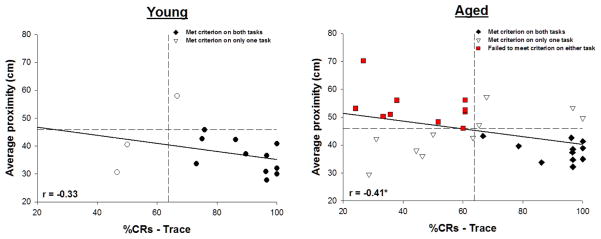Figure 3.
Performance during trace conditioning correlated with spatial memory in aged, but not young, rats. In young rats the greatest percentage of conditioned responses (CRs) emitted by each animal during any session of trace conditioning did not significantly correlate with that animal’s average proximity across the three probe tests (r = −0.33, p≥0.05). However, performance during trace conditioning and water maze testing did significantly correlate in aged animals (r = −0.41, p<0.05). Vertical dashed line indicates criterion for trace conditioning. Horizontal dashed line indicates criterion for water maze testing. Black circles indicate young rats that achieved criterion on both tasks, whereas white circles indicate young rats that achieved criterion on only one task. Diamonds indicate aged rats that achieved criterion on both tasks, triangles indicate aged rats that achieved criterion on only one task, and squares indicate aged rats that failed to achieve criterion on both tasks. A much greater degree of behavioral heterogeneity was observed in aged animals. Asterisk (*) indicates p<0.05.

